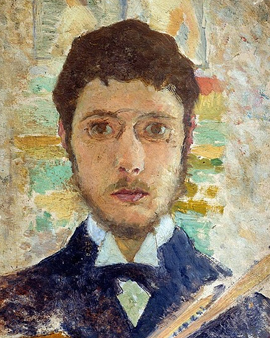Pierre Bonnard, born near Paris in 1867, is one of the Post-Impressionists with his light-flooded, colorful paintings. The painter, who initially studied law, joined the Nabis in 1888. They referred to Paul Gauguin, attached great importance to decorative elements and felt a connection between design and graphics.
Bonnard increasingly found his own pictorial language, which harmonized a cheerful palette of colors with two-dimensional forms. "Bouquet of Wild Flowers" from 1922 shows how he pays attention to detail and fans out the tablecloth, background and individual flowers in beautiful colour facets. It is about feeling for the beauty of a fresh bouquet of flowers and the perception of an environment which itself has decorative features. Portraits also belong to Bonnard's group of works: "Teddy Godeski Writes" is not only devoted to the concentrated female figure looking down, but also to the ornamental background. A yellow pillow and the mirror image are the focal points.
Bonnard was not an extroverted artist. He lived in various places, repeatedly painting nudes, still lifes, and views out of windows. Domestic scenes that demonstrate his eye for the extraordinary in everyday life, such as "Breakfast" from 1932 and 1936, are also among his preferred motifs. Bonnard uses a firework of colors to bring a feeling for what is happening in the light-flooded room onto the canvas. The striking red tablecloth with the large teapot first draws the viewer's gaze to the centre of the picture, then moves out of the window into the distance to a lush green landscape with a yellow house. More important than colours of reality are feelings and focal points that can create colours.
×





.jpg)
.jpg)
.jpg)
.jpg)
.jpg)
.jpg)
.jpg)
.jpg)
.jpg)
.jpg)
.jpg)
.jpg)
.jpg)
.jpg)
.jpg)
.jpg)
.jpg)
.jpg)
.jpg)
.jpg)
.jpg)
.jpg)
.jpg)
.jpg)
.jpg)
.jpg)
.jpg)
.jpg)
.jpg)
.jpg)
.jpg)
.jpg)
.jpg)
.jpg)
.jpg)
.jpg)
.jpg)
.jpg)
.jpg)
.jpg)
.jpg)
.jpg)
.jpg)
.jpg)
.jpg)
.jpg)
.jpg)
.jpg)
.jpg)
.jpg)
.jpg)
.jpg)
.jpg)
.jpg)
.jpg)
.jpg)
.jpg)
.jpg)
.jpg)
.jpg)
.jpg)
.jpg)
.jpg)
.jpg)
.jpg)
.jpg)
.jpg)
.jpg)
.jpg)
.jpg)
.jpg)
.jpg)
.jpg)
.jpg)
.jpg)
.jpg)
.jpg)
.jpg)
.jpg)
.jpg)
.jpg)
.jpg)
.jpg)
.jpg)
.jpg)
.jpg)
.jpg)
.jpg)
.jpg)
.jpg)
.jpg)
.jpg)
_-_(MeisterDrucke-891177).jpg)
_-_(MeisterDrucke-891177).jpg)
_-_(MeisterDrucke-422298).jpg)
_-_(MeisterDrucke-422298).jpg)
.jpg)
.jpg)
.jpg)
.jpg)
_-_(MeisterDrucke-1061578).jpg)
_-_(MeisterDrucke-1061578).jpg)
.jpg)
.jpg)
.jpg)
.jpg)
.jpg)
.jpg)
.jpg)
.jpg)
.jpg)
.jpg)
_-_(MeisterDrucke-891361).jpg)
_-_(MeisterDrucke-891361).jpg)
.jpg)
.jpg)
.jpg)
.jpg)
_1_-_(MeisterDrucke-960875).jpg)
_1_-_(MeisterDrucke-960875).jpg)
.jpg)
.jpg)
.jpg)
.jpg)
_-_(MeisterDrucke-689114).jpg)
_-_(MeisterDrucke-689114).jpg)
.jpg)
.jpg)
.jpg)
.jpg)
.jpg)
.jpg)
.jpg)
.jpg)
.jpg)
.jpg)
_-_(MeisterDrucke-890944).jpg)
_-_(MeisterDrucke-890944).jpg)
.jpg)
.jpg)
.jpg)
.jpg)
.jpg)
.jpg)
.jpg)
.jpg)
.jpg)
.jpg)
.jpg)
.jpg)
_-_(MeisterDrucke-1065770).jpg)
_-_(MeisterDrucke-1065770).jpg)
.jpg)
.jpg)
.jpg)
.jpg)
.jpg)
.jpg)
.jpg)
.jpg)
.jpg)
.jpg)
.jpg)
.jpg)
.jpg)
.jpg)
_1908_-_(MeisterDrucke-1001746).jpg)
_1908_-_(MeisterDrucke-1001746).jpg)
.jpg)
.jpg)
.jpg)
.jpg)
_1919_Saint_T_-_(MeisterDrucke-1003005).jpg)
_1919_Saint_T_-_(MeisterDrucke-1003005).jpg)
.jpg)
.jpg)
.jpg)
.jpg)
.jpg)
.jpg)
.jpg)
.jpg)
.jpg)
.jpg)
.jpg)
.jpg)
.jpg)
.jpg)
_1892_Nabis_Dim_15x_-_(MeisterDrucke-1004535).jpg)
_1892_Nabis_Dim_15x_-_(MeisterDrucke-1004535).jpg)
_-_(MeisterDrucke-691310).jpg)
_-_(MeisterDrucke-691310).jpg)
.jpg)
.jpg)
.jpg)
.jpg)
_-_(MeisterDrucke-691595).jpg)
_-_(MeisterDrucke-691595).jpg)
.jpg)
.jpg)






